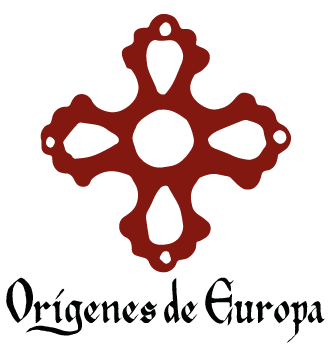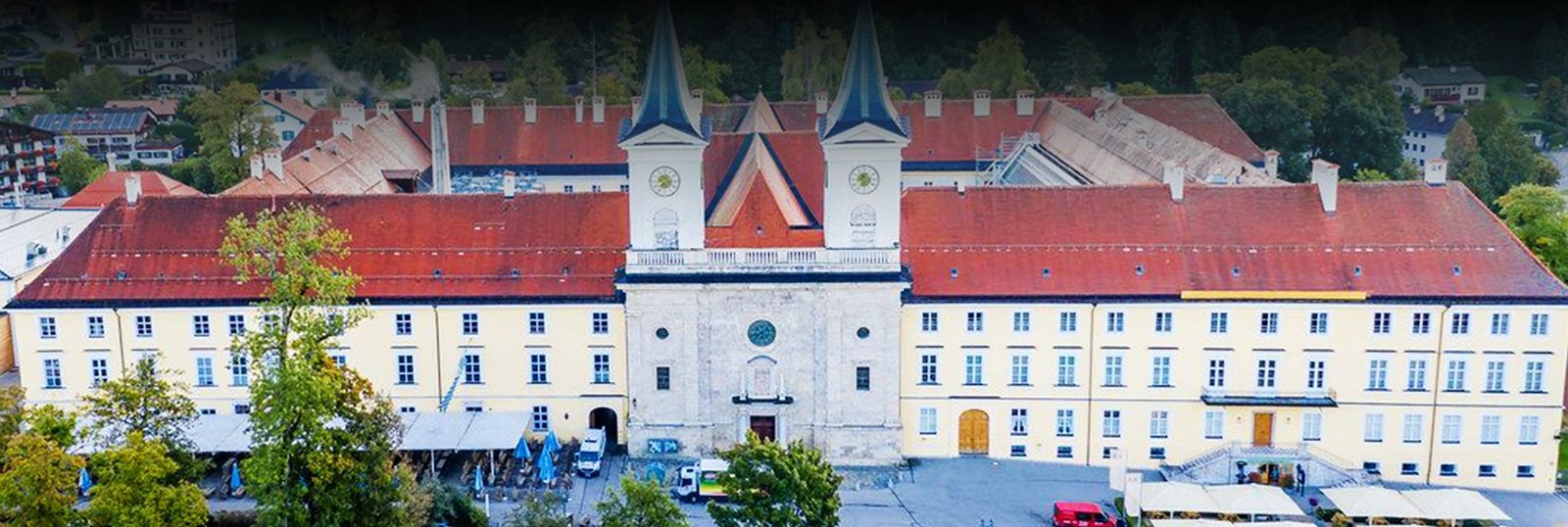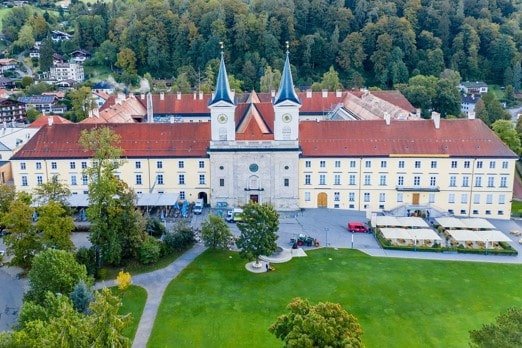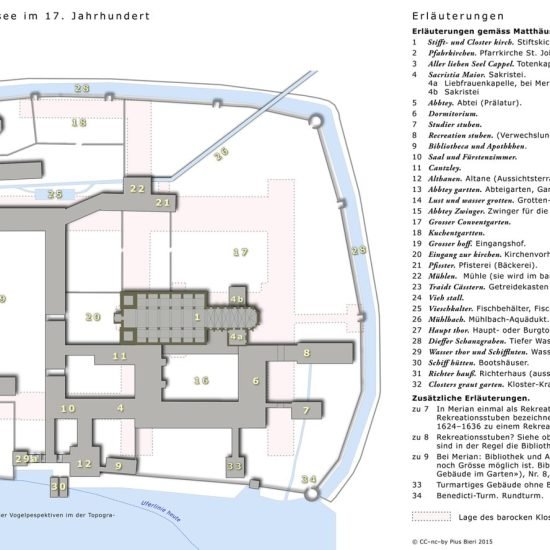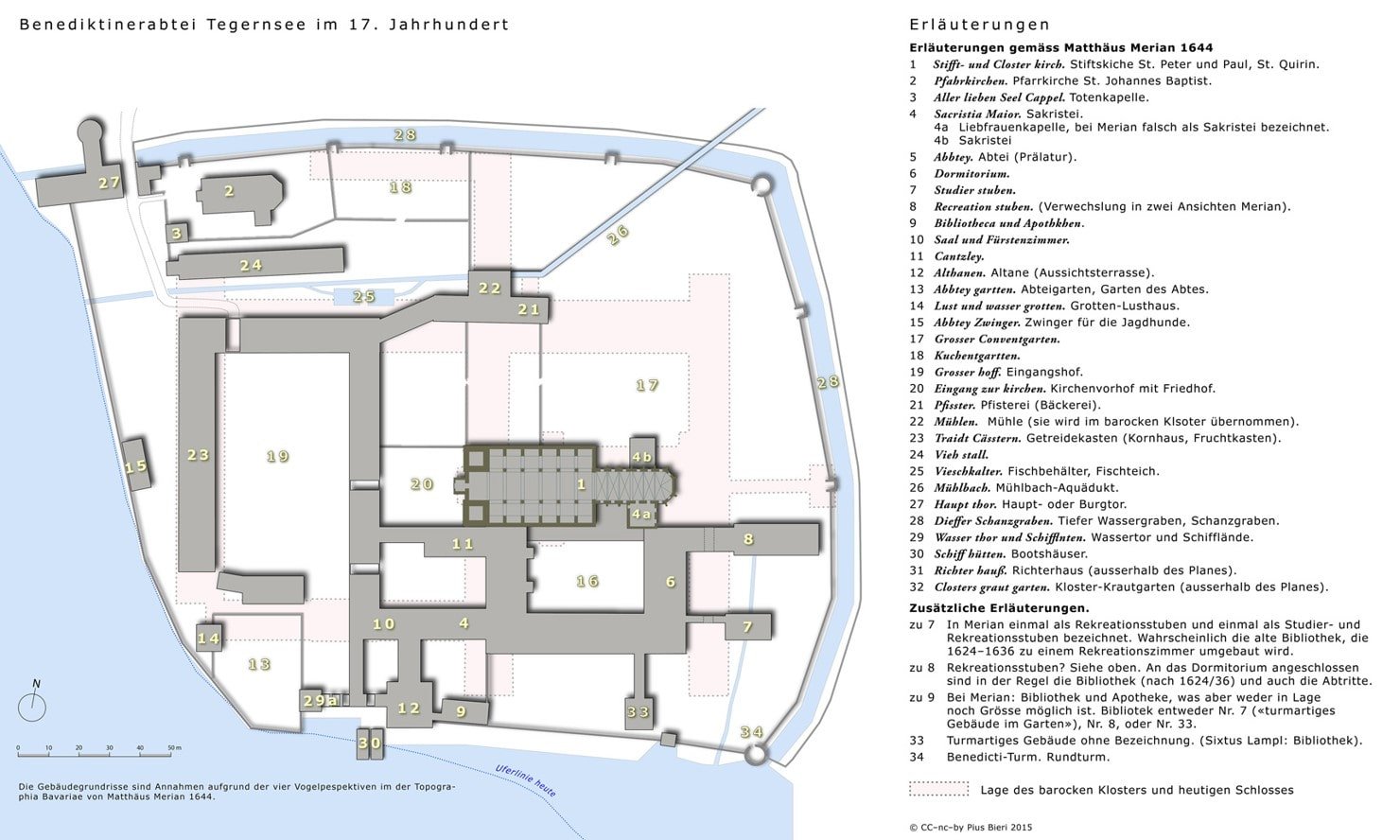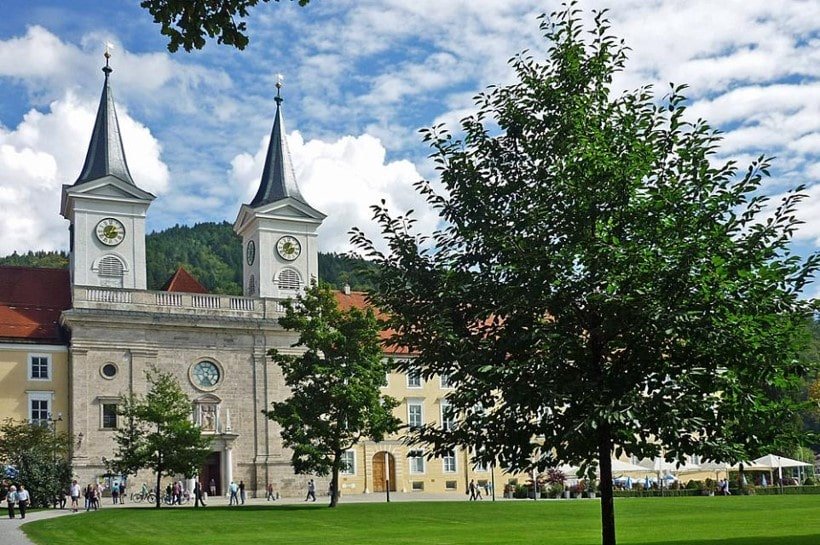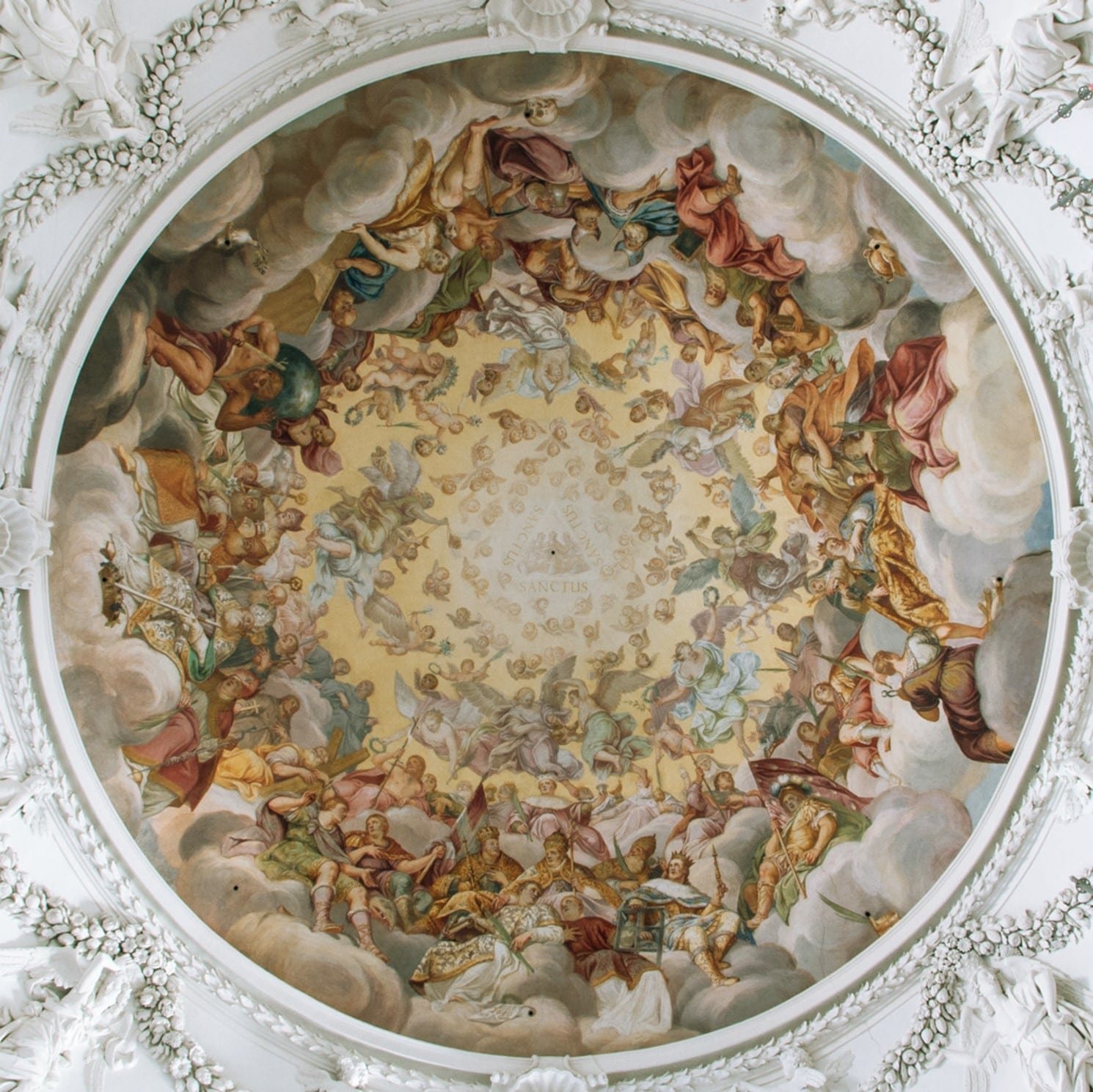Tegernsee Abbey
per person
The abbey in Tegernsee is a former Benedictine monastery that is located directly on Lake Tegernsee. The abbey, like the town that grew out of it, is named after the lake, whose name can be translated from the Old German, tegarin seo, meaning large lake. Founded in the 8th century, the abbey represented one of the most important Benedictine communities in Bavaria until 1803. Today, however, the former monastery building is known as Tegernsee Castle and is owned by the Wittelsbach family. The former monastery church became the local parish church of St. Quirinus. Today, the large grounds also house the well-known Herzoglich Bayerisches Brauhaus Tegernsee brewery, restaurant, brew pub and Tegernsee Gymnasium.
FORMAL ANALYSIS
The former monastery and today’s parish church of St. Quirin stands in the center of the building complex. The oldest remains here are part of the crypt and the untethered western double-tower facade, which may still date back to a new construction of the monastery in 980. The abbey church, built in the 10th century in Carolingian style, was transformed into a Romanesque basilica in the 11th century, which in turn was transformed into a Gothic church in the 15th century – between 1455 and 1460. The large three-nave basilica (no transept) was completed in 1476 and still structurally forms the core of the monastery church. The interior of the roof truss and the two west towers on the bell floor are also still characterized by the masonry of that time. In addition, the roof trusses of the spires are still present, although changed in their external form.
Following the plans of Enrico Zuccalli, the baroqueization of the church began in 1678, during which a crossing and a transept were also added. Until about 1690 Hans Georg Asam also created the rich stuccowork and the elaborate picture program in the vault. The monastery complex, which surrounds the church, is still a four-winged complex with plasterwork and two inner courtyards, as it was built by Enrico Zuccalli and from 1689 to 1736 by Antonio Riva, Johann Schmuzer and Johann Baptist Gunetzrhainer.
From 1678, according to the plans of Enrico Zuccalli, the baroqueization of the church took place, adding also a crossing and a transept. At that time, the rich stucco-work and the complex picture program in the vault by Hans Georg Asam were created until around 1690. Today, the monastery complex surrounding the church is a four-winged complex with a plaster structure that includes two inner courtyards. The complex was built in 1678 according to an ideal plan by Enrico Zuccalli and from 1689 to 1736 by Antonio Riva, Johann Schmuzer and Johann Baptist Gunetzrhainer.
Unfortunately, even the Baroque furnishings are hardly preserved today. Of the original 17 altars only five are preserved and only two side chapel altars in the style of that time. The altars in the transept were reworked in the classical style and the high altar mixes both styles with its baroque finish of the psalli choir in the lower part and the classical painted altarpiece in the lower part. Unfortunately, since 1803 the choir stalls, the high altar in the psalm choir and eleven other altars have disappeared.
When the monastery was abolished, significant parts of the complex were then demolished. These include the large staircase, the stables, and the guest apartments that formerly surrounded the courtyard in front of the church façade. In 1820, the eastern psalm choir in the church was detached and redesigned by Leo von Klenze, who transformed the entire complex into a royal summer palace. This complex also includes the former Secretum – the so-called Apothekerstöckl – which is a two-story hipped roof building with rusticated entrance risalit from the 18th century.
Also worth seeing is the monument in honor of Queen Caroline, built in the south of the monastery complex in 1870 by Johann von Halbig and now a protected monument. The former Ebertshausen Castle and the Kaltbrunn estate were also part of the monastery’s property for a time.
FLORIAN HARTMANN
- TEGERNSEE ABBEY© PICTURE BY MARCO VERCH UNDER CREATIVE COMMONS 2.0, https://foto.wuestenigel.com/kloster-tegernsee-ehemalige -abtei-der-benediktiner-heute-sitz-der-tegernseer-brauerei-luftbild/
- EXTERIOR VIEW OF THE PARISH CHURCH ST. QUIRIN IN TEGERNSEE© FOT. SchiDD, Wikimedia Commons (CC BY-SA 3.0 de), https://www.alpen-guide.de/reisefuehrer/poi/st-quirinus-tegernsee
- INTERIOR F THE PARISH CHURCH OF ST. QUIRINUS WITH HIGH BAROQUE STUCCO DRESS AND ASAM FRESCOES© FOT. https://architekt-peter.de/portfolio/1130-pfarrkirche-st-quirinus/
- DOME FRESCO IN THE PARISH CURCH OF ST. QUIRINUS, SIGNATED BY HANS GEORG ASAM IN 1690© FOT. https://www.sueddeutscher-barock.ch/In-Werke/s-z/Tegernsee.html
Tour Location
Tegernsee Abbey
| Other monuments and places to visit | Empire Fountain (Schweighof) 1821; Villa Faber, house of Emanuel von Seidl (1899-1903); Wallbergbahn Olaf Gulbransson museum; Tegernsee city hall |
| Natural Heritage | The wooded Flyschberge near Bad Wiessee are among the most valuable natural treasures in the foothills of the Alps |
| Historical Recreations | |
| Festivals of Tourist Interest | Bergfilm-Festival Tegernsee. First-class films about mountaineering actions, fascinating nature documentaries or quiet depictions of everyday life in the mountains of the world - such topics and films have attracted mountain and nature lovers to Tegernsee in droves every October since 2003 |
| Fairs | |
| Tourist Office | Yes |
| Specialized Guides | No |
| Guided visits | No |
| Accommodations | There is no accommodation directly in the former abbey, but around it are numerous hotels |
| Restaurants | Tegernseer Schloßrestaurant |
| Craft | |
| Bibliography | |
| Videos | |
| Website | tegernsee.com tripadvisor.de |
| Monument or place to visit | Tegernsee Abby |
| Style | Early-gothic, Renaissance and Baroque style |
| Type | Romanesque, Gothic, Baroque |
| Epoch | 10th, 15th, 17/18th century |
| State of conservation | Good condition |
| Mailing address | Schloßplatz 1D, 83684 Tegernsee |
| Coordinates GPS | 11°45′30″N 47°42′44″O |
| Property, dependency | The former collegiate church, as a parish church, is now the property of the Catholic church foundation; the state still has subsidiary building obligations. The south and east convent wings, a castle since 1817, have belonged to the state again since 1979. The west wings on both sides of the church and the north wing remain in the possession of the Wittelsbach family. They also own the Tegernsee brewery, whose two inns today occupy the entire length of the first floors of the west wings on both sides of the church and also of the north wing |
| Possibility of visits by the general public or only specialists | A tour of the castle is not possible. The catholic parish church St. Quirinus (former monastery church) can be visited |
| Conservation needs | |
| Visiting hours and conditions | |
| Ticket amount | |
| Research work in progress | |
| Accessibility | |
| Signaling if it is registered on the route | |
| Bibliography | Bauer, Hermann; Bauer, Anna: Klöster in Bayern. Eine Kunst- und Kulturgeschichte. München 1985, S. 68-71. Geiger, Simon: Kloster Tegernsee. Ein Kulturbild (Beiträge zur altbayerischen Kirchengeschichte 15). München 1936, insb. S. 126-136. Guldan, Ernst: Italienische Stukkatoren in Bayern, in: Arte e artisti dei laghi lombardi, Como 1964. Götz Roland: St. Quirinus Tegernsee, Kunstführer, Regensburg 2009. Hartig, Michael: Die Benediktinerabtei Tegernsee 746-1803. Kurzer Überblick über ihre Geschichte und ihre Verdienste um Wissenschaft und Kunst zur Zwölfhundert-Jahrfeier vom 15. bis 22. September 1946. München 1946. Hemmerle, Josef: Die Benediktinerklöster in Bayern (Germania Benedictina 2). Augsburg 1970, S. 297-304. Lampl, Sixtus: Die Klosterkirche Tegernsee, in: Oberbayrisches Archiv, Band 100, mit Ergänzungsband. München 1975. Lindner, Pirmin: Familia S. Quirini in Tegernsee. II. Teil, in: Oberbayrisches Archiv für vaterländische Geschichte, Ergänzungsheft zum 50. Band. München 1898. Von Bezold, Gustav et al.: Die Kunstdenkmale des Regierungsbezirkes Oberbayern, 2. Theil, München 1902. |
| Videos | kbw-miesbach.de (Detailed Tour, 18 episodes) Youtube Youtube (St. Quirinus Church) |
| Information websites | sueddeutscher-barock.ch mrfh.de wikipedia.org hdbg.eu |
| Location | Tegernsee, Miesbach County, Bavaria, Germany |
